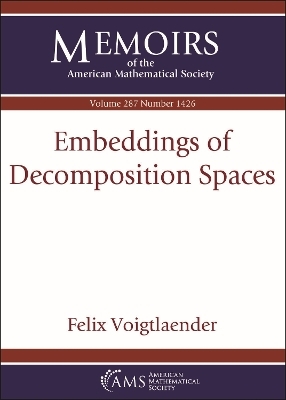
Embeddings of Decomposition Spaces
Seiten
2023
American Mathematical Society (Verlag)
978-1-4704-5990-1 (ISBN)
American Mathematical Society (Verlag)
978-1-4704-5990-1 (ISBN)
Many smoothness spaces in harmonic analysis are decomposition spaces. In this paper we ask: Given two such spaces, is there an embedding between the two? In a nutshell, in order to apply the embedding results presented in this article, no knowledge of Fourier analysis is required.
Many smoothness spaces in harmonic analysis are decomposition spaces. In this paper we ask: Given two such spaces, is there an embedding between the two?
A decomposition space D(Q, Lp, Y ) is determined by a covering Q = (Qi)i?I of the frequency domain, an integrability exponent p, and a sequence space Y ? CI . Given these ingredients, the decomposition space norm of a distribution g is defined as g D(Q,Lp,Y ) = F?1 (?i · g ) Lp i?I Y , where (?i)i?I is a suitable partition of unity for Q.
We establish readily verifiable criteria which ensure the existence of a continuous inclusion ("an embedding") D(Q, Lp1 , Y ) ? D(P, Lp2 , Z), mostly concentrating on the case where Y = q1 w (I) and Z = q2 v (J). Under suitable assumptions on Q,P, we will see that the relevant sufficient conditions are p1 ? p2 and finiteness of a nested norm of the form (?i?j · vj/wi)i?Ij t j?J s , with Ij = {i ? I : Qi ? Pj = ?} for j ? J .
Like the sets Ij , the exponents t, s and the weights ?, ? only depend on the quantities used to define the decomposition spaces.
In a nutshell, in order to apply the embedding results presented in this article, no knowledge of Fourier analysis is required; instead, one only has to study the geometric properties of the involved coverings, so that one can decide the finiteness of certain sequence space norms defined in terms of the coverings.
These sufficient criteria are quite sharp: For almost arbitrary coverings and certain ranges of p1, p2, our criteria yield a complete characterization for the existence of the embedding. The same holds for arbitrary values of p1, p2 under more strict assumptions on the coverings.
Many smoothness spaces in harmonic analysis are decomposition spaces. In this paper we ask: Given two such spaces, is there an embedding between the two?
A decomposition space D(Q, Lp, Y ) is determined by a covering Q = (Qi)i?I of the frequency domain, an integrability exponent p, and a sequence space Y ? CI . Given these ingredients, the decomposition space norm of a distribution g is defined as g D(Q,Lp,Y ) = F?1 (?i · g ) Lp i?I Y , where (?i)i?I is a suitable partition of unity for Q.
We establish readily verifiable criteria which ensure the existence of a continuous inclusion ("an embedding") D(Q, Lp1 , Y ) ? D(P, Lp2 , Z), mostly concentrating on the case where Y = q1 w (I) and Z = q2 v (J). Under suitable assumptions on Q,P, we will see that the relevant sufficient conditions are p1 ? p2 and finiteness of a nested norm of the form (?i?j · vj/wi)i?Ij t j?J s , with Ij = {i ? I : Qi ? Pj = ?} for j ? J .
Like the sets Ij , the exponents t, s and the weights ?, ? only depend on the quantities used to define the decomposition spaces.
In a nutshell, in order to apply the embedding results presented in this article, no knowledge of Fourier analysis is required; instead, one only has to study the geometric properties of the involved coverings, so that one can decide the finiteness of certain sequence space norms defined in terms of the coverings.
These sufficient criteria are quite sharp: For almost arbitrary coverings and certain ranges of p1, p2, our criteria yield a complete characterization for the existence of the embedding. The same holds for arbitrary values of p1, p2 under more strict assumptions on the coverings.
Felix Voigtlaender, Catholic University of Eichstatt-Ingolstadt, Germany.
| Erscheinungsdatum | 19.08.2023 |
|---|---|
| Reihe/Serie | Memoirs of the American Mathematical Society ; Volume: 287 Number: 1426 |
| Verlagsort | Providence |
| Sprache | englisch |
| Maße | 178 x 254 mm |
| Themenwelt | Mathematik / Informatik ► Mathematik ► Analysis |
| ISBN-10 | 1-4704-5990-6 / 1470459906 |
| ISBN-13 | 978-1-4704-5990-1 / 9781470459901 |
| Zustand | Neuware |
| Haben Sie eine Frage zum Produkt? |
Mehr entdecken
aus dem Bereich
aus dem Bereich
Buch | Softcover (2024)
De Gruyter Oldenbourg (Verlag)
59,95 €
Buch | Softcover (2024)
De Gruyter Oldenbourg (Verlag)
59,95 €


